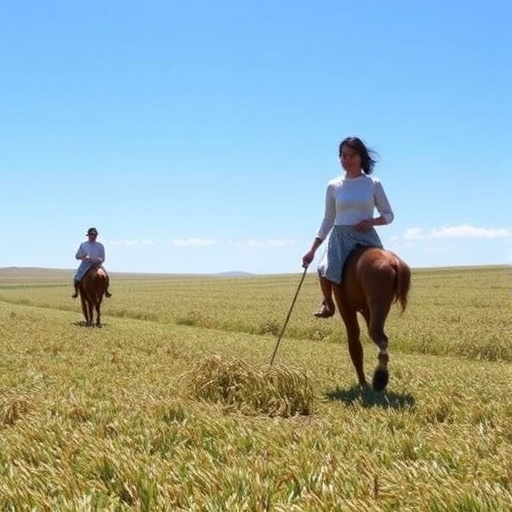In a groundbreaking interdisciplinary study, researchers have unveiled intricate details about the earliest advancements in agricultural practices in Central Europe, dating back nearly seven millennia. This extensive investigation elucidates the gradual integration of novel cereal varieties into the farming repertoire of Neolithic societies, shedding light on their adaptive strategies to fluctuating environmental conditions in the Rhineland region of present-day Germany. Through meticulous analysis spearheaded by prominent archaeologists and scientists from the Universities of Cologne and Frankfurt, the study enhances understanding of how early farming communities dynamically evolved their crop cultivation methods between the 6th and early 4th millennia BCE.
This new research delves deeply into the Linear Pottery Culture, the initial wave of Neolithic farmers who settled Central Europe around 5,400 to 4,900 BCE. These pioneering agrarians predominantly cultivated emmer and einkorn wheats—ancient spelt varieties requiring labor-intensive dehulling processes to remove outer husks before consumption or processing. While previous scholarship acknowledged the emergence of naked wheat and barley in later Neolithic phases, this study uniquely refines the chronological framework and unravels the agricultural mechanisms underpinning this crop diversification. The findings consequently disrupt prior assumptions by pinpointing the early onset of such innovations at the beginning of the Middle Neolithic period, approximately between 4,900 and 4,500 BCE.
Central to the study’s methodology was the comprehensive collection and statistical analysis of archaeobotanical macroremains, primarily charred grain fragments, unearthed from 72 Neolithic settlements within the Rhineland archaeological zone. These charred remains, preserved in settlement pits, serve as invaluable proxies for reconstructing ancient farming practices and crop diversity. Employing advanced multivariate statistical techniques, the research team parsed complex datasets to detect distinct agricultural phase shifts and nuanced changes in crop spectra over time. This quantitative approach allowed for unprecedented differentiation between Neolithic phases, illuminating temporal trends otherwise obscured in qualitative assessments.
One of the study’s pivotal revelations was that the Middle Neolithic agricultural transition occurred earlier and more abruptly than traditionally documented. By integrating new cereal grains such as naked wheat, which circumvented the dehulling step, farmers not only optimized labor efficiency but also augmented the robustness and flexibility of their cultivation systems. This diversification facilitated the simultaneous planting of both winter and summer crops, expanding the agricultural calendar and enabling exploitation of a broader array of ecological niches and soil types. These adaptations collectively signify an emergent sophisticated understanding of agroecology among these prehistoric communities.
Diversity analysis within the dataset revealed a crescendo in cereal variety cultivation around 4,350 BCE, marking a zenith in agricultural heterogeneity. Following this peak, a discernible contraction in crop diversity suggests the onset of further transformative processes within the farming systems. This pattern indicates a possible strategic reorganization of food production, likely dovetailing with increasing specialization in other subsistence activities, such as intensified livestock herding. Preliminary evidence points toward a reinforcement of cattle farming during this subsequent phase, underscoring a complex interplay between crop cultivation and animal husbandry in Neolithic economies.
The research outcomes underscore the remarkable adaptability of early farmers to regional environmental constraints. In geographically challenging areas characterized by poorer soils or harsher climatic regimes, agriculturalists selectively cultivated cereal species with elevated resilience or yield potential under such conditions. Such strategic crop choice highlights a profound localized ecological knowledge and an ability to tailor food production strategies to microenvironmental variations. It marks a departure from previous views that depicted Neolithic agriculture as a uniform, static practice, emphasizing instead dynamic and context-sensitive management.
This study not only enriches archaeological narratives but also offers broader implications for understanding human-environment interactions and the evolution of sustainable agricultural practices. The adaptive flexibility evidenced by these early farming communities parallels contemporary concerns regarding climate variability and agricultural resilience. Insights into how prehistoric societies balanced crop diversity, labor investment, and ecological constraints may inform modern agronomic research focused on crop diversification and soil management.
Technically, the application of multivariate analysis to archaeobotanical macroremains represents a methodological advance, enabling researchers to interpret complex interactions between agricultural practices and environmental factors quantitatively. This statistical framework facilitates the identification of subtle temporal shifts in cultivation patterns that traditional typological or descriptive methods might overlook. The integration of multiple scientific disciplines—including archaeobotany, dendroarchaeology, and zooarchaeology—further bolsters the robustness of interpretations by cross-validating findings through diverse lines of evidence.
The project’s success hinged upon extensive collaboration across scientific domains and institutions, demonstrating the value of interdisciplinary approaches in excavating the past’s complexity. The German Research Foundation-funded initiative exemplifies how pooling expertise in vegetation history, prehistoric archaeology, and statistical modeling can transform fragmentary archaeological data into comprehensive reconstructions of ancient human lifeways. As the research continues to explore late Neolithic transformations, ongoing analyses are expected to yield further revelations about the interplay of agricultural evolution and socio-environmental dynamics.
In sum, this pioneering investigation reframes the narrative of Neolithic agriculture in Central Europe, illustrating how early farmers were not merely passive cultivators but active innovators. By incorporating new cereal species, diversifying crop types, and adapting cultivation strategies in response to environmental variability, these communities laid foundational principles for sustainable food production. Their legacy resonates profoundly in contemporary dialogues about agricultural resilience and ecological stewardship, reiterating that the seeds of innovation were sown thousands of years ago in the fertile soils of the Rhineland.
Subject of Research: Early Neolithic agricultural development and crop diversification in the Rhineland region through archaeobotanical and multivariate statistical analysis.
Article Title: Dynamics of early agriculture – multivariate analysis of changes in crop cultivation and farming practices in the Rhineland (Germany) between the 6th and early 4th millennium BCE
News Publication Date: 25-Sep-2025
Web References: http://dx.doi.org/10.1016/j.jas.2025.106369
Image Credits: Tanja Zerl, University of Cologne
Keywords: Neolithic agriculture, crop diversification, archaeobotany, Linear Pottery culture, emmer wheat, einkorn wheat, naked wheat, barley, multivariate analysis, prehistoric farming, Rhineland archaeology, early European farming practices, agricultural resilience




